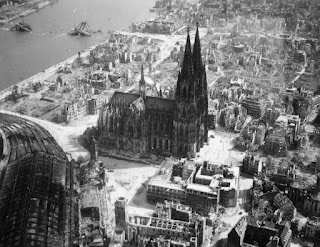No letter today. Just this:
Route of the Question Mark

[CLICK TO ENLARGE]

(A) Merzenich to (B) Elsdorf, Germany (12 miles)
1 March to 2 March 1945

[CLICK TO ENLARGE]

(A) Merzenich to (B) Elsdorf, Germany (12 miles)
1 March to 2 March 1945
March 2... Elsdorf. We collected an assemblage of drakes, ducks, chickens, and rabbits from this deserted town, and spent hours roaming in all directions for souvenirs. The advance party spent a sleepless night due to enemy air activity.
* TIDBIT *
about Operation "Lumberjack"
[CLICK TO ENLARGE]

about Operation "Lumberjack"
[CLICK TO ENLARGE]

From "U.S. Army in WWII European Theater of Operations: The Last Offensive" by Charles B. MacDonald for the Department of the Army's Office of the Chief of Military History, Chapter X, page 185, published in 1973 in Washington, D.C. comes this excerpt:
As VII Corps fought its way toward Cologne, the RAF pulverized what was left of the city from previous bombing raids, once again leaving the Cathedral unscathed. From "The Porage Diaries" comes the following excerpts:

Cologne without Rooftops - Bomb Attack 2 March 1945

Bomber over Devastated Cologne - 2 March 1945

Bombs Away Over Cologne - 2 March 1945
Before General Omar Bradley could turn full attention to gaining the west bank of the Rhine, Supreme Commander General Eisenhower gave him the assignment to extend his protection of the Ninth Army's right flank by clearing a triangle of land between the Erft and the Rhine extending northward from Cologne to the confluence of the two rivers near Duesseldorf.
Bradley logically gave the assignment to the First Army's General Hodges for execution by Collins's VII Corps. Once the job was completed, the VII Corps was to take Cologne, then head south along the Rhine. As Collins turned south, other contingents of the First Army were to launch a narrow thrust from the vicinity of the road center of Euskirchen southeast to the Ahr River, there to converge with a thrust by the Third Army through the Eifel and create a pocket of trapped Germans in the northern reaches of the Eifel.
Bradley's plan went by the code name Operation LUMBERJACK...
Bradley logically gave the assignment to the First Army's General Hodges for execution by Collins's VII Corps. Once the job was completed, the VII Corps was to take Cologne, then head south along the Rhine. As Collins turned south, other contingents of the First Army were to launch a narrow thrust from the vicinity of the road center of Euskirchen southeast to the Ahr River, there to converge with a thrust by the Third Army through the Eifel and create a pocket of trapped Germans in the northern reaches of the Eifel.
Bradley's plan went by the code name Operation LUMBERJACK...
As VII Corps fought its way toward Cologne, the RAF pulverized what was left of the city from previous bombing raids, once again leaving the Cathedral unscathed. From "The Porage Diaries" comes the following excerpts:
By day break on 2nd March 1945, and within thirteen hours of landing back from a mission at Mannheim, nine RAF crews had been de-briefed, slept, eaten two meals, attended a fresh briefing and were actually airborne en route for Cologne, together with seven other crews. Exceptionally clear weather conditions, combined with precise Pathfinder Force markings, resulted in a highly effective raid by 858 aircraft. With once again the miraculous exception of its cathedral, Cologne, by now almost a front line city, suffered considerable damage in this last RAF raid - only four days later it was occupied by American troops...

Cologne without Rooftops - Bomb Attack 2 March 1945

Bomber over Devastated Cologne - 2 March 1945

Bombs Away Over Cologne - 2 March 1945
Throughout all of World War II, Cologne endured 262 air raids by the Western Allies, which caused approximately 20,000 civilian casualties and almost completely wiped out the center of the city. During the night of 31 May 1942, Cologne was the site of "Operation Millennium", the first 1,000 bomber raid by the Royal Air Force in World War II. 1,046 heavy bombers attacked their target with 1,455 tons of explosives. This raid lasted about 75 minutes, destroyed 600 acres (243 ha) of built-up area, killed 486 civilians and made 59,000 people homeless. By the end of the war, the population of Cologne was reduced by 95%. This loss was mainly caused by a massive evacuation of the people to more rural areas. The same happened in many other German cities in the last two years of war.


No comments:
Post a Comment